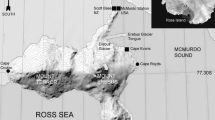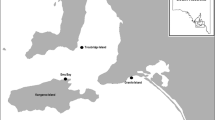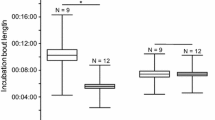Abstract
The intensity of stone collection and stone theft by breeding Chinstrap penguins was measured, and estimations made of the number of stones per nest in large (> 400 nests) and small subcolonies (< 50 nests) in the large Vapour Col colony on Deception Island, South Shetland Islands. Stone availability was significantly higher both inside and outside small subcolonies. Penguins carried stones to the nest at the same rate in large and small subcolonies, but stole more intensively in large subcolonies. Stones obtained by theft were significantly larger than those collected elsewhere. When stone availability was increased experimentally, individuals of large subcolonies collected more intensively than control individuals in large and small subcolonies, and stole significantly less than control individuals in large subcolonies, and as much as individuals in small subcolonies. The greater theft pressure in large subcolonies was accompanied by more aggressive defence by nest owners and by reduced succession stealing. However, the reduced availability of stones on the ground near large subcolonies led to a significantly lower number of stones per nest than in small subcolonies. These results are interpreted in the light of the geometric effects of breeding group size (perimeter to surface ratio) on stone accessibility.
Similar content being viewed by others
References
Ainley D (1975) Displays of Adélie penguins: a reinterpretation. In: Stonehouse B (ed) Biology of penguins. University Park Press, Baltimore, pp 503–534
Alexander RD (1974) The evolution of social behavior. Annu. Rev. Ecol. Syst. 5:325–383
Bagshawe TW (1938) Notes on the habits of the gentoo and ringed or Antarctic penguins. Trans Zool Soc London XXIV:185–291
Balda RP, Bateman GC (1972) The breeding biology of the pinion jay. Living Bird 11:5–42
Burger J (1974) Breeding adaptations of Franklin's gull (Larus pipixcan) to a marsh habitat. Anim Behav 22:521–567
Burger J (1981) A model for the evolution of mixed-species colonies of Ciconiiformes. Rev Biol 56:143–167
Collias EC, Collias NE (1978) Nest building and nesting behaviour of the sociable weaver Philetarius socius. Ibis 120:1–15
Coombs CJF (1960) Observations on the rook Corvus frugilegus in southwest Cornwall. Ibis 102:394–419
Cullen E (1957) Adaptations in the kittiwake to cliff-nesting. Ibis 99:275–302
Hoogland JL, Sherman PW (1976) Advantages and disadvantages of bank swallow (Riparia riparia) coloniality. Ecol Monogr 46:33–58
Levick GM (1915) Natural history of the Adélie penguin. British Museum (Natural History), London
Moreno J, Bustamante J, Viñuela J (1995) Nest maintenance and stone theft in the Chinstrap penguin Pygoscelis antarctica. I. Sex roles and effects on fitness. Polar Biol 15:533–540
Penney RL (1968) Territorial and social behavior in the Adélie penguin. Antarct Res Ser 12:83–131
Pomeroy DE (1978) The biology of Marabou storks in Uganda. 2. Breeding biology and general review. Ardea 66:1–23
Sapin-Jaloustre J, Bourlière F (1951) Incubation et développement du poussin chez le Manchot Adélie Pygoscelis adeliae. Alauda Rev Int Ornithol 2:65–82
Schleicher B, Valera F, Hoi H (1993) The conflict between nest guarding and mate guarding in penduline tits (Remiz pendulinus). Ethology 95:157–165
Sladen WJL (1958) The pygoscelid penguins, Parts 1 and 2. Sci Rep Falkland Islands Dependency Surv 17:1–97
Spurr EB (1975) Communication in the Adélie penguin. In: Stonehouse B (ed) Biology of penguins. University Park Press, Baltimore, pp 449–501
Tenaza R (1971) Behavior and nesting success relative to nest location in Adélie penguins (Pygoscelis adeliae). Condor 73:81–92
Wittenberger JF, Hunt GL (1985) The adaptive significance of coloniality in birds. In: Farner DS, King JR (eds) Avian biology, vol VIII. Academic Press, New York, pp 1–78
Yeates GW (1975) Microclimate, climate and breeding success in Antarctic penguins. In: Stonehouse B (ed) Biology of penguins. University Park Press, Baltimore, pp 397–409
Author information
Authors and Affiliations
Rights and permissions
About this article
Cite this article
Carrascal, L.M., Moreno, J. & Amat, J.A. Nest maintenance and stone theft in the Chinstrap penguin (Pygoscelis antarctica). Polar Biol 15, 541–545 (1995). https://doi.org/10.1007/BF00239645
Received:
Accepted:
Issue Date:
DOI: https://doi.org/10.1007/BF00239645




